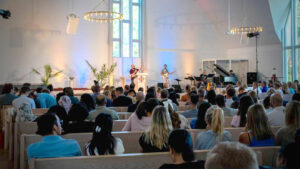The demise of evangelicalism, megachurches, and orthodox Christianity is regularly announced these days, but I admit I’m a bit skeptical of most of these reports. As a friend of mine is fond of saying, half of all statistics are made up on the spot, and the other half can be made to mean whatever you want them to.
Recently there’s been some chatter about the imminent demise of contemporary worship music. Given the resurgent interest in hymns and liturgy, the narrative goes, churches are beginning to turn away from the lights and smoke of contemporary worship to these older traditions. Most recently, Rod Dreher wrote an interesting piece, “Kill Your Megachurch Worship,” in which he essentially offers an “amen” to Jonathan Aigner’s article on the reasons “contemporary worship” is or should be in decline.
While I’m a little skeptical of the decline narrative (just look at the streaming and download numbers for Hillsong’s “Oceans”), there was a lot in Dreher’s article I really appreciated. He and Aigner argue for the value of the liturgy, and for a reorientation of our priorities around depth and spiritual formation—away from the of-the-moment entertainmentism of much contemporary worship. I’ve argued for much of the same in Rhythms of Grace: How the Church’s Worship Tells the Story of the Gospel.
But there are a few things worth disputing. For starters, I’m afraid their discussion of contemporary worship treats it as if it were a monolithic culture, all shallow, all flash, all driven by consumerism and trends. This simply isn’t true, and a careful look reveals that even within a given movement there are both shallows and deeps. Likewise, “traditions” often have their own flaws. Dreher notes one friend who lamented his Baptist church’s forsaking of their traditional hymns, to which I’d want to ask, “Which hymnal?” A few decades ago, Heavenly Highway Hymns was one of the most popular and bestselling hymnals in America, and while it contains a few treasures of English hymnody, it also contains drivel like “Build Me a Cabin in the Corner of Heaven.” Contemporary music doesn’t own a monopoly on sentimentality and shallowness.
Dreher also argues that being out of fashion and out of sync, culturally, is a good thing. Hang on to tradition, he argues, and you’ll be on solid ground. The problem with this line of thought is that it ignores how much of what comes to us as “tradition” was, in its own day, innovation. Thomas Cranmer’s Book of Common Prayer is one example; Cranmer carefully curated that book to provide the best possible resources for scattered parishes, using technology (namely, the printing press) to enrich the worship of churches who wouldn’t have had access to theological and liturgical libraries. Likewise, Isaac Watts was compelled to write his hymns out of concern that the church’s primary resources for singing—metrical Psalm translations—were clumsy, aesthetically impoverished, and theologically opaque. Watts wanted the church to sing the gospel, and many of his songs aren’t just translations, they’re theological translations, showing all the ways that the imagery of the Psalms pointed to Jesus. (Read his own introduction to them for his full argument and reasoning for this approach.)
Pinpointing the Problem 
I would argue that the problem isn’t contemporary innovations, and the answer isn’t (necessarily) tradition. The problem is with the church’s understanding of the purpose and goal of worship. What are we seeking to accomplish with our gatherings? Is the church gathering for the purpose of robustly forming people with the story of the gospel, with remembering and renewing her covenant with God? And is everything that happens in the gathering serving that end?
To me, that question shines a light not only on the trouble with many contemporary worship gatherings, but also on the trouble with many traditional gatherings. After all, if fidelity to tradition and theological depth in the liturgy were what the church really needed to fortify itself against the cultural pressures of liberalism and secularism, then why have mainline denominations experienced such dramatic decline and abandoned orthodoxy on so many issues? As my friend Chip Stam used to say, it’s strange that you can attend a worship service with a rich Christ-centered liturgy and hear a sermon that almost wholeheartedly refutes it.
Clearly, more is needed than good liturgy and good hymns.
Zeroing in on Celebrity Culture
At the same time, we shouldn’t let contemporary worship off the hook completely. Much of what Dreher and Aigner say about deserves a hearty “amen.” But rather than focus on musical styles—which are always the topic of debates, trends, and preferences (just read J. S. Bach’s letters)—I think we should zero in more closely on the trouble with celebrity culture. Celebrity culture turns pastors and worship leaders into icons. Celebrity culture turns worship gatherings into rock concerts. Celebrity culture confuses flash and hype for substance.
Celebrity culture turns pastors and worship leaders into icons.
Celebrity culture turns worship gatherings into rock concerts.
Celebrity culture confuses flash and hype for substance.
Here I cannot help but think of the bewildering phenomenon of Donald Trump and his candidacy for the Republican nomination. What else but celebrity culture can account for his poll numbers? And before you dismiss this as an unrelated aside, I would point to the many stories, oft-repeated, of celebrity pastors whose actions—be it bullying, financial impropriety, or other sins—get overlooked because of their compelling presence on the platform, their large audiences, and their charisma.
Celebrity worship is one of the central religions of our secular age. Celebrities are icons—they embody an image of what we think the good life is, and we aspire to that life for ourselves. Just as people flock to Kim Kardashian because she embodies what they desire—sex, money, beauty, power, and fame—people flock to Christian celebrities because they embody desires as well. In some cases, the desires are just as shallow; an awful lot of celebrity pastors and worship leaders are young, good-looking, well-coifed, and well-dressed. They get reality TV shows, and if they don’t have a reality show, they live a lifestyle that wouldn’t be out of place with one, complete with entourages and outlandish antics.
In other cases—and I think this is just as common—we flock to celebrity pastors and worship leaders because they represent the piety, passion, and faith we wish we had ourselves. The worship of celebrities is endemic to our culture, and Christians can absorb and practice it without even realizing they’re doing it. Thus it’s just as easy to worship Joel Osteen, whose actions seem to invite it, as it is to worship John Piper or Tim Keller, who most certainly don’t. They’re worshiped—as are countless other local pastors—because we’re primed to think that people on platforms embody our hopes and ideals.
Ultimately, this worship leads to disappointment and frustration. In the church especially, our “heroes” can rarely live up to the idealized standards we impose on them. This leads me back to Dreher’s article, where he observes how millennials are longing for liturgy. This too, I think, is a reaction to celebrity culture. Generally speaking, I think liturgical services do a better job than revivalistic contemporary services of centering on God rather than centering on the personalities on the platform.
What’s at the Center of Your Gathering?
While I’m defensive of the value of contemporary music in a church gathering, I do think much about “megachurch worship” deserves scrutiny. Many of the cultural artifacts part and parcel of the megachurch experience are used unthoughtfully, such as video feeds and image magnification, with tight camera shots on musicians or preachers, or smoke machines and laser lights, or “artistic” video backdrops scrolling behind song lyrics. These often get defended with some version of “it’s all about Jesus,” and an argument that these cultural artifacts are morally neutral.
But let’s just take image magnification as one example: How else and where else do churchgoers experience it? They find it at sporting events, concerts, and political rallies, displaying larger-than-life images of athletes, rock stars, and politicians. Is it possible that using a “neutral” technology like IMAG subtly reinforces our tendency to make idols and icons out of pastors and worship leaders? Does that question even get asked in most contexts?
On this point worship leaders in contemporary contexts should pay careful attention. We must ask what’s at the center of our gatherings. Is it an emotional ride, led by a hip, handsome, and passionate rock star, followed by (to borrow a phrase from James K. A. Smith) “a 45-minute lecture from the smartest guy in the room,” or is the gathering focused on the Word of God, a Spirit-filled congregation singing “psalms, hymns, and spiritual songs” together, and the Lord’s Supper? Is the church a gathering and sending of saints, or a rally for a fan club?
Is the church a gathering and sending of saints, or a rally for a fan club?
As cultures shift and change, the church’s worship has always shifted and changed with it. In our day, we should be suspicious of the overhyped promises of megachurch worship, but we should also be suspicious of overhyped laments for “the good ol’ days.” What’s truly needed today is what was needed in every age: liturgical renewal—faithful pastors leading in worship that is faithful to the gospel, comprehensible to the congregation, and formative of the soul. That will look radically depending on whether you’re gathering with an Orthodox parish in Louisiana or a multiethnic congregation in an impoverished Louisville neighborhood. But in either case, it can buttress the church against the ever-shifting pressures of our age.
Download your free Christmas playlist by TGC editor Brett McCracken!
 It’s that time of year, when the world falls in love—with Christmas music! If you’re ready to immerse yourself in the sounds of the season, we’ve got a brand-new playlist for you. The Gospel Coalition’s free 2025 Christmas playlist is full of joyful, festive, and nostalgic songs to help you celebrate the sweetness of this sacred season.
It’s that time of year, when the world falls in love—with Christmas music! If you’re ready to immerse yourself in the sounds of the season, we’ve got a brand-new playlist for you. The Gospel Coalition’s free 2025 Christmas playlist is full of joyful, festive, and nostalgic songs to help you celebrate the sweetness of this sacred season.
The 75 songs on this playlist are all recordings from at least 20 years ago—most of them from further back in the 1950s and 1960s. Each song has been thoughtfully selected by TGC Arts & Culture Editor Brett McCracken to cultivate a fun but meaningful mix of vintage Christmas vibes.
To start listening to this free resource, simply click below to receive your link to the private playlist on Spotify or Apple Music.


































